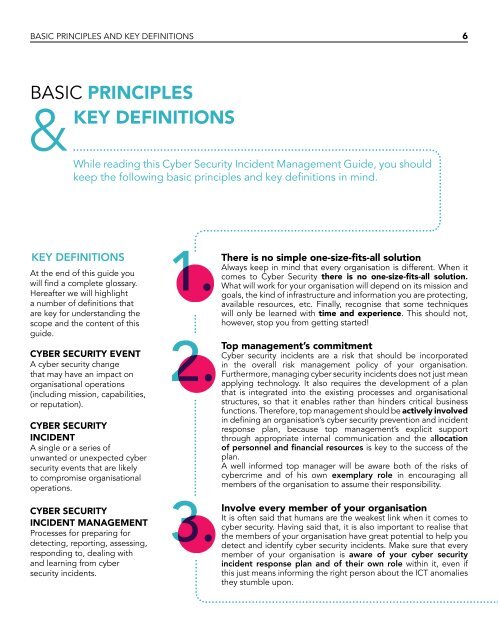CYBER SECURITY INCIDENT MANAGEMENT GUIDE
Cyber-Security-Incident-Management-Guide-2015
Cyber-Security-Incident-Management-Guide-2015
You also want an ePaper? Increase the reach of your titles
YUMPU automatically turns print PDFs into web optimized ePapers that Google loves.
BASIC PRINCIPLES AND KEY DEFINITIONS 6<br />
BASIC PRINCIPLES<br />
KEY DEFINITIONS<br />
&While reading this Cyber Security Incident Management Guide, you should<br />
keep the following basic principles and key definitions in mind.<br />
KEY DEFINITIONS<br />
At the end of this guide you<br />
will find a complete glossary.<br />
Hereafter we will highlight<br />
a number of definitions that<br />
are key for understanding the<br />
scope and the content of this<br />
guide.<br />
<strong>CYBER</strong> <strong>SECURITY</strong> EVENT<br />
A cyber security change<br />
that may have an impact on<br />
organisational operations<br />
(including mission, capabilities,<br />
or reputation).<br />
<strong>CYBER</strong> <strong>SECURITY</strong><br />
<strong>INCIDENT</strong><br />
A single or a series of<br />
unwanted or unexpected cyber<br />
security events that are likely<br />
to compromise organisational<br />
operations.<br />
1.<br />
2.<br />
There is no simple one-size-fits-all solution<br />
Always keep in mind that every organisation is different. When it<br />
comes to Cyber Security there is no one-size-fits-all solution.<br />
What will work for your organisation will depend on its mission and<br />
goals, the kind of infrastructure and information you are protecting,<br />
available resources, etc. Finally, recognise that some techniques<br />
will only be learned with time and experience. This should not,<br />
however, stop you from getting started!<br />
Top management’s commitment<br />
Cyber security incidents are a risk that should be incorporated<br />
in the overall risk management policy of your organisation.<br />
Furthermore, managing cyber security incidents does not just mean<br />
applying technology. It also requires the development of a plan<br />
that is integrated into the existing processes and organisational<br />
structures, so that it enables rather than hinders critical business<br />
functions. Therefore, top management should be actively involved<br />
in defining an organisation’s cyber security prevention and incident<br />
response plan, because top management’s explicit support<br />
through appropriate internal communication and the allocation<br />
of personnel and financial resources is key to the success of the<br />
plan.<br />
A well informed top manager will be aware both of the risks of<br />
cybercrime and of his own exemplary role in encouraging all<br />
members of the organisation to assume their responsibility.<br />
<strong>CYBER</strong> <strong>SECURITY</strong><br />
<strong>INCIDENT</strong> <strong>MANAGEMENT</strong><br />
Processes for preparing for<br />
detecting, reporting, assessing,<br />
responding to, dealing with<br />
and learning from cyber<br />
security incidents.<br />
3.<br />
Involve every member of your organisation<br />
It is often said that humans are the weakest link when it comes to<br />
cyber security. Having said that, it is also important to realise that<br />
the members of your organisation have great potential to help you<br />
detect and identify cyber security incidents. Make sure that every<br />
member of your organisation is aware of your cyber security<br />
incident response plan and of their own role within it, even if<br />
this just means informing the right person about the ICT anomalies<br />
they stumble upon.


